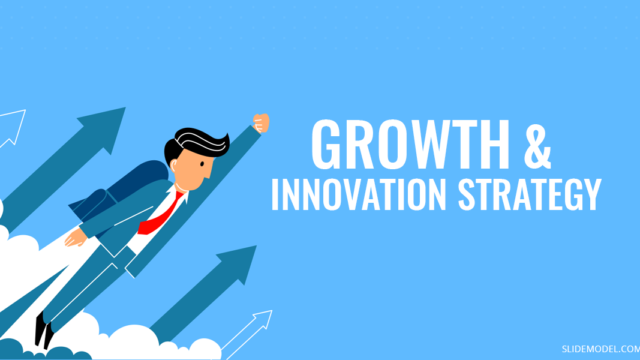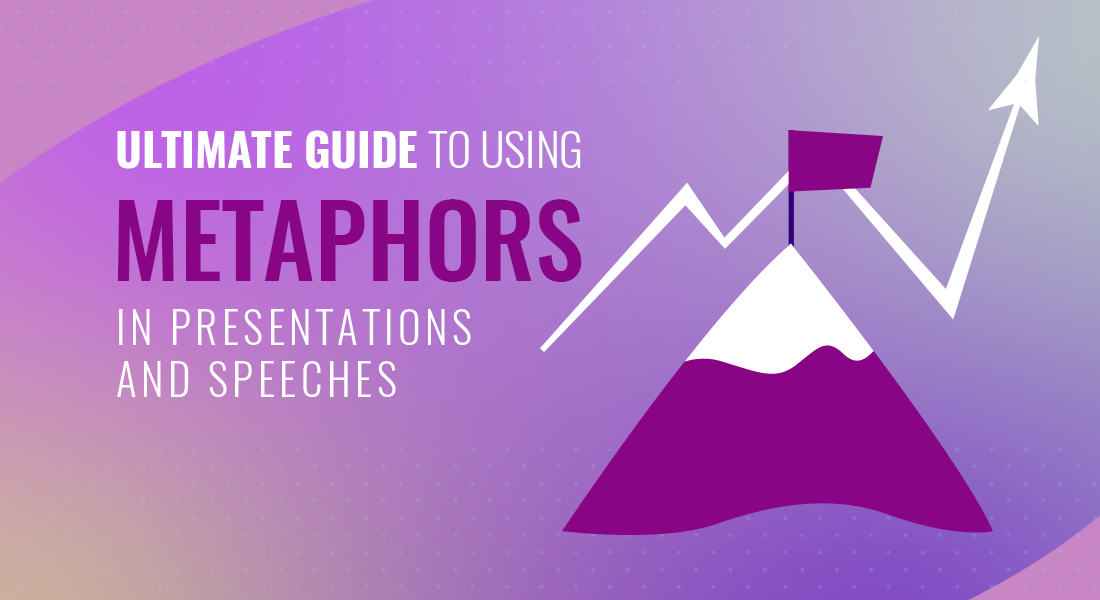
Metaphors are one of the often-forgotten tricks among presenters. Along with other figures of speech such as similes, analogies personification, and alliteration, they make your texts more engaging, memorable and eloquent. As well, metaphors serve as a great tool for breaking down complex concepts into more digestible statements.
In this guide, we’ll show you how to artfully use metaphors in your presentations and speeches. And you can scroll down to the bottom part for 25+ metaphor examples. Let’s dive in!
Defining the Metaphor
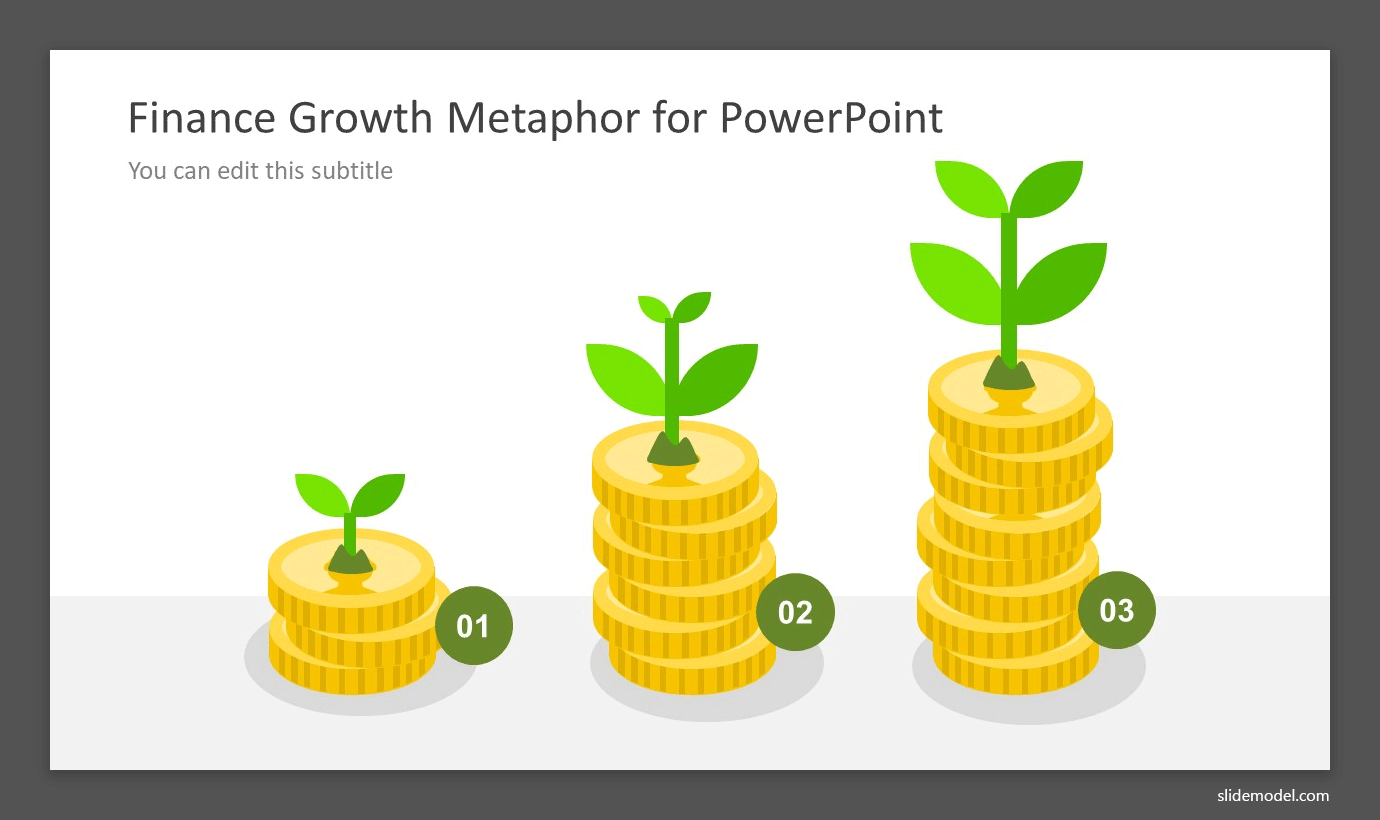
Finance Growth Metaphor PowerPoint Template by SlideModel
A metaphor is a figure of speech that compares two things, people, ideas, etc.by stating that one is the other. The two are not similar, of course, and the purpose of the comparison is for emphasis, symbolism, or adding humor/color to an author’s language.
A few famous metaphor examples are as follows:
- “All the world’s a stage” – William Shakespeare
- “Conscience is a man’s compass” – Vincent Van Gogh
- “You ain’t nothing but a hound dog, been snoopin’ round my door, you can wag your tail, but I ain’t gonna’ feed you no more” – Elvis Presley, “Hound Dog” Song.
The Simile vs. the Metaphor
As mentioned earlier, metaphor is just one of the many speech figures you can use to create comparisons.
A simile is the second most used tool for that. Both the simile and the metaphor compare two, unlike things. A simile, though, compares these two by using the words “like” or “as.” Thus, “He was like a pressure cooker, ready to explode.”
As a metaphor, this statement would be, “He was a pressure cooker, ready to explode.”
The Analogy vs. the Metaphor
An analogy is a lengthier comparison, a short narrative that explains the relationship between two different things. A metaphor makes a comparison using a short phrase, to provide emphasis but not a full explanation. The metaphor is left for the listener or reader to form in his own mind.
So, an analogy might read, “A captain is to his ship as a coach is to his team.”
The metaphor might read, “A coach is the captain of his ship.”
Why Use Metaphors in Your Presentations and Speeches
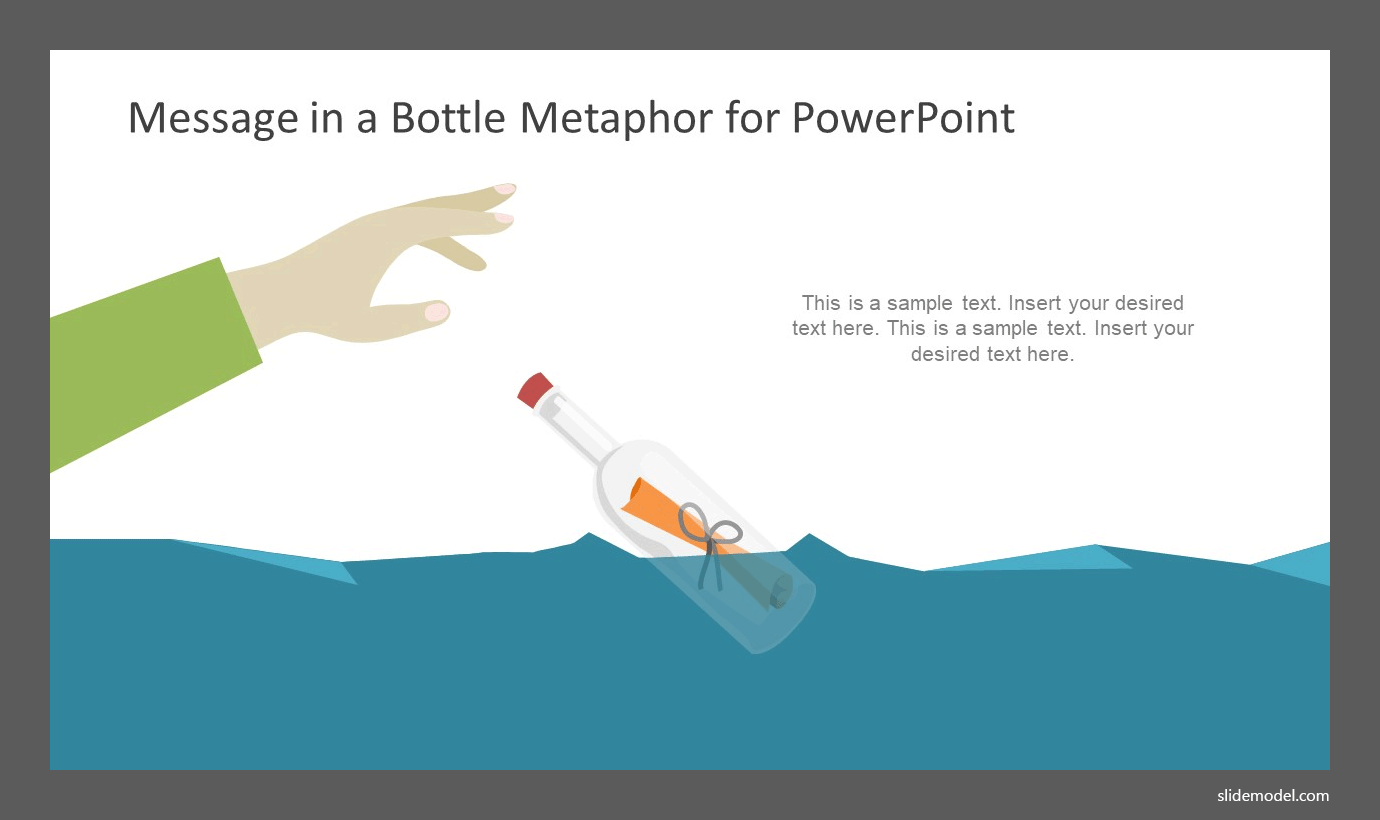
Message in a Bottle Metaphor PowerPoint Design by SlideModel
Speeches and presentations, particularly those that have a lot of information, data, and perhaps some tough concepts, can turn an audience off. They may suffer from overload, confusion, and, probably most often, plain boredom.
Metaphors can help you cope with all of the above in the following way:
Metaphors can help an audience visualize something intangible in a tangible way
What, for example, does “reliable” really mean? You can use synonyms like “trustworthy,” but they are intangible too. Gerald Zaltman, the author of Marketing Metaphoria, uses the example of insurance companies and the metaphors they use to convey reliability – Traveler’s umbrella, Allstate’s hands, and Prudential’s rock.
Here are a few more metaphors that tangibly allow visualization of the intangible.
- Love is: a garden, a nutrient, an experiment, a thrill ride, a battlefield, a fine wine
- Truth and Justice: Truth is solid; Justice is a liquid
- Freedom: Freedom is a gust of wind letting you spread your wings.

Source: Gear & Puzzle Metaphor illustration by SlideModel
Many companies use what are called “deep metaphors” as they market their products. Deep metaphors are more complex and lengthy metaphors based upon some intangible such as peace, relaxation, and even joy and freedom. Harley-Davidson is a great example pointed by Zaltman in his book. The metaphor is that riding a Harley is the same as those intangibles, and they provide great visuals people can access in their minds.
Organic food companies use metaphors in their marketing all the time. Thus, processed foods with lots of additives are pollution to the body. Organic foods, on the other hand, are the cleansers of the body.
They engage an audience by giving them something they can relate to
People have many situations in common to which they can all relate – procrastination, lack of focus, not enough time to get everything done, lack of sleep, accidents, etc. Each of these can be the subjects of metaphoric comparisons.
Lack of focus can be compared to a cluttered closet, for example. That cluttered closet is disorganized, things are strewn about in no order, and finding important items can be very tough.
Procrastination is a thief of time. Time metaphors, in fact, are some of the most common metaphors used in speeches and presentations on many topics. And they are also often used in literature:
- “Time is an equal opportunity employer…” The Joy of Working by Denis Waitley
- “Time is but the stream I go fishing in.” Walden Pond by Henry David Thoreau
- “Time is a gift, given to you…” “The Phantom Tollbooth” by Norton Juster
Metaphors are persuasive
Politicians often use metaphors to provide a persuasive context for the points they want to make and to get listeners to “buy-in” to their beliefs, opinions, and proposals.
Martin Luther King was a master of metaphors in both his speeches and writings. And those metaphors made his works so much more compelling. Consider just a few from his famous speech, “I Have a Dream.”
- “Seared in the flames of injustice,” referring to the seeking of justice but being denied due to racism
- He also refers to the “vast ocean of prosperity” and the “lonely island of poverty”
- He speaks to the inequality of justice as the “storms of persecution”
Presidents have used metaphors in speeches to garner support for what they want to do.
- In his 1933 inaugural address, Franklin Roosevelt compared the people, fighting together to beat the Depression as an army. “I assume unhesitatingly the leadership of the great army of our people dedicated to a disciplined attack upon our common problems.”
- President John Kennedy needs support for the cost of his space program. At a dedication of the Aerospace Medical Center in Texas, he stated, “America has tossed its cap over the wall of space,” indicating that the U.S. would enter the space race and win.
- Bill Clinton, in his inaugural address of 1993, announced a major shift in the policies and goals. “And you have changed the face of Congress, the Presidency, and the political process itself. Yes, you, my fellow Americans, have forced the spring. Now we must do the work the season demands.” Spring has always been a metaphor for new beginnings and hope, especially in poetry.
Finally, they can move the common up to new levels
For instance, instead of merely stating the expected and boring “our new software is a great sales tool”, you can reinforce your idea and pack in additional context by saying that: “Our new sales software is a rocket ship that will catapult your business to the stratosphere of productivity”.

Source: Metaphor illustration by SlideModel
How to Start Using Metaphors in Your Speeches and Presentations
Effective metaphors should simplify the concept, not leave the audience wondering what exactly you were trying to say. Thus, it takes a bit of practice and some creative thought to come up with great metaphors. Below are several quick tips to help you with that.
Use a Metaphoric Theme
Instead of coming up with a series of scattered metaphors, stick with one theme. Doing so will help you maintain interest and avoid confusion.
For example, if you are saying that your app has “Zeus-like powers”, continue with the Greek mythology theme within the rest of your presentation. You can further state that dealing with some industry problems is similar to battling a Medusa and sometimes to find the right solution and get out of the labyrinth, one will need an Ariadne thread.
This trick of using themed metaphors is also called “extended metaphor”.
Custom Metaphors Should Always Be Relevant
It may be tempting to come up with truly out-of-the-box metaphors. But don’t rush to do so. After all, the audience will best relate to metaphors that are relevant and within their experience. Otherwise, they’ll fail to fully grasp the concept you are pitching and feel disengaged.
Use Metaphors to Add Some Spice to Data
Audiences may hear the figure $1 trillion but almost ignore that figure because it is hard to visualize in their heads. So, how about using a time metaphor? “One dollar is one second in time. One trillion dollars is 32,000 years in seconds. Our National Debt is over $23 trillion, so that is 23 times 32,000. Who has the answer for how many years that is?”
Add a Metaphor to The Opening Slide to Set a Scene
When you can use a great, engaging metaphor for your opening slide in a presentation, you will grab attention right away. If you can pique curiosity and interest upfront, your audience is far more willing to “tune in.”
Close with a Metaphor for Additional Emphasis
If you began with the metaphor, “Turn Your Work into a Box of Chocolates,” and you have used that extended metaphor throughout your presentation, then that metaphor should carry through to your closing. If you have compared each type of candy in that box to a type of task (hard nut, creamy centers, medium-soft caramels, etc.), then speak to the order in which they might be prioritized or varied to achieve maximum productivity.
A Big List of Metaphor Examples For All Types of Topics
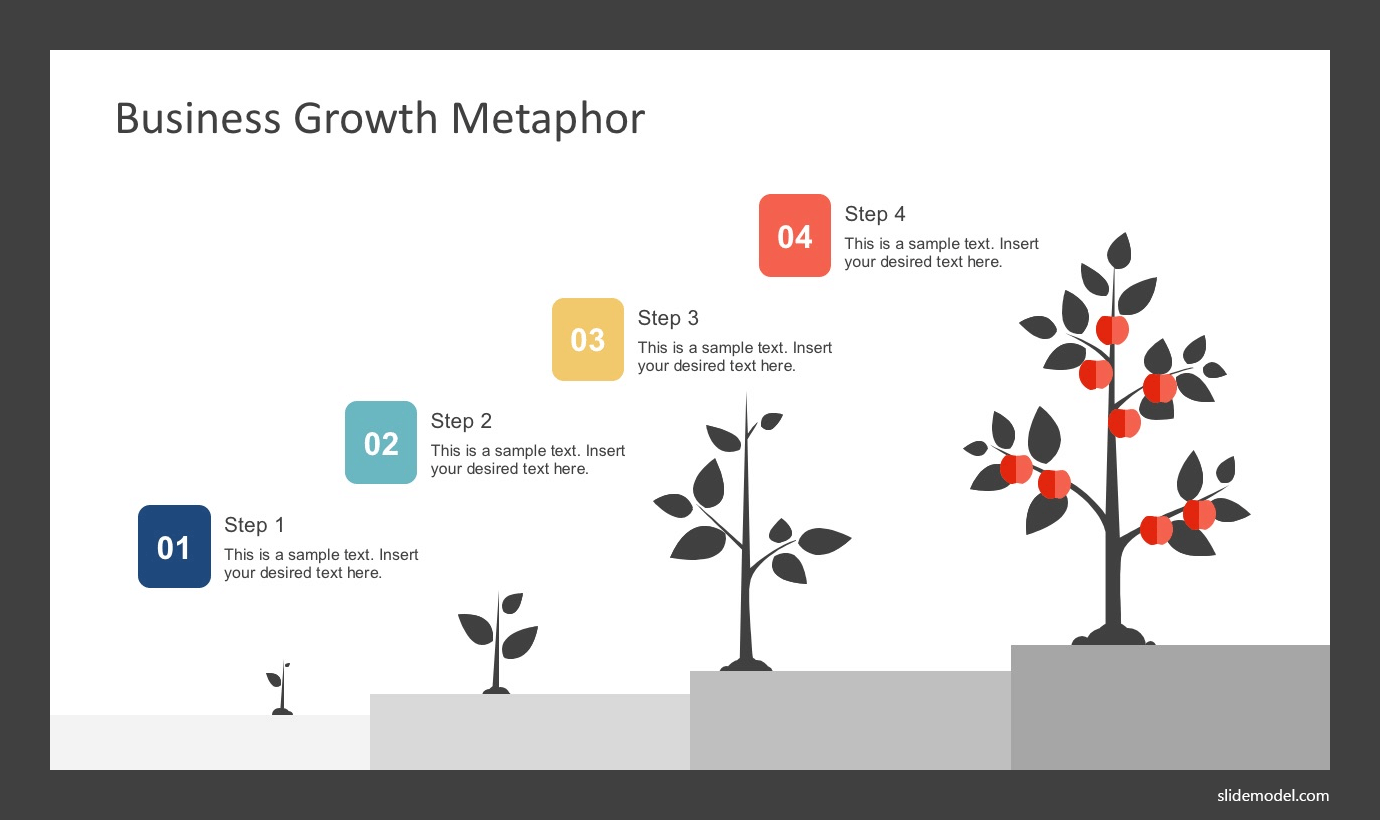
Free Business Growth Metaphor Template for PowerPoint by SlideModel
Business Metaphors
- Products are solutions. This is a relatively new type of business metaphor and is often used in marketing collateral. The concept is that people buy products to solve a problem they have – they want nicer skin, a reliable car, a better phone, etc. Marketers offer solutions to these needs and problems.
- Business growth is horticulture. This metaphor is somewhat common but spot-on when entrepreneurs think about the step-by-step process that occurs. Seeds are sown and require water and sunlight (investment). Growth cannot be rushed, and if nourished properly and sequentially, the harvest (success) will be great.
- Companies are ships with a captain and designated roles and responsibilities for everyone on that ship. Again, this is common but quite neat.
Metaphors for Success
- “She’s the kind of girl who climbed the ladder of success wrong by wrong.”, Mae West.
- “The sweet smell of success.” – a novelette by Ernest Lehman and musical based upon the novelette.
- “Failure is the condiment that gives success its flavor.” – Truman Capote
Metaphors for Freedom
- “I have a dream that one day even the state of Mississippi, a state sweltering with the heat of injustice, sweltering with the heat of oppression, will be transformed into an oasis of freedom and justice” Martin Luther King’s ‘I Have a Dream Speech’ in 1963
- “I can taste the aroma of liberation” – Poem “Of Surrealism and Reality” by Millard Lowe.
- Freedom is a bonfire that began as just a few sparks from twigs. It grows as you do and your idea of freedom matures over time.
Metaphors for Ideas
- An idea can be a wall. It stops you dead in your tracks and forces you in a new direction.
- “A library, to modify the famous metaphor of Socrates, should be the delivery room for the birth of ideas…” – Norman Cousins
- “Bobby Holloway says my imagination is a three-hundred-ring circus.” Seize the Night by Dean Koontz
Metaphors for Leadership
- “You are pioneers. Nobody has been where you’re going. So, it’s your job to go there and leave a trail. It’s everyone else’s job to follow.” Delaine Hampton, speaking to her team charged with a new research initiative at Proctor and Gamble.
- Fear of any challenge is a giant, and until that giant is whittled down to a smaller and manageable size, a team can succumb to that fear. It is the leader’s job to whittle down that giant to a manageable and conquerable size. – Metaphor adapted from a story told by Paul Smith, keynote speaker and author of the book, Lead With a Story.
- A leader is a conductor of a symphony. – Martha Denton, consultant and presenter, and founder/CEO of The Presentation School.
Metaphors for Hard Work
- Hard work is rowing upstream. It may seem like you are making little progress, but, step by step, you do reach your destination.
- Those who work hard are lasers. They are focused beams of light that stay on target.
- “Life for me ain’t been no crystal stair” – from “Mother to Son” by Langston Hughes
Metaphors for Time
- Time is a parade. It marches forward, no matter how big the crowd, no matter how many or few cheers there are, and no matter what the weather. Using time wisely means ignoring all of these distractions.
- Time is an enemy for those who waste it.
- “Time’s a trap, I’m caught in it.” from “The Handmaid’s Tale” by Margaret Atwood
Metaphors for Knowledge
- Knowledge is light. It eliminates the darkness of ignorance and lack of understanding.
- “Knowledge as Love” Keynote Address by Daniel Andriessen at the 8th European Conference on Knowledge Management, 2007
- “Knowledge is power” attributed to Sir Francis Bacon from his “Meditationes Sacrae.”
Metaphors for Growth
- Business Growth: “Small microelectronic companies suddenly sprouted all over the valley.: – Ian Mackenzie, Professor of Financial English, Heinle Cengage Learning.
- Personal growth is a bamboo tree. No one can see that growth for four years. But in the fifth year, it comes forth and grows exponentially. – Tom Speaks, Impact Group Leadership Academy.
- “We grow like one note becoming a tune” Tyler Stenson, songwriter.
The topic list of metaphors is almost in-exhaustible. Your speech or presentation might use metaphors for strength, metaphors for change, or metaphors for productivity or teamwork. The overall point is that, if you can use a metaphor to make something more relevant or engaging, then do so. Just don’t overdo. An entire speech or presentation filled with metaphors will turn your audience off too. And avoid mixed metaphors. People cannot be eagles soaring in the sky and flowers that blossom at the same time – this is just confusing.
Conclusion
Figurative language has stood the test of time. It is used by authors, famous philosophers, inventors, scientists, politicians, songwriters, TV personalities, and, yes, far less famous people who write and make speeches. Metaphors are one of the most popular because they can provide visual, relevant, and unique comparisons of two very unlike things. Consider incorporating their use in your next speech or presentation – you may find your audience response quite positive.
